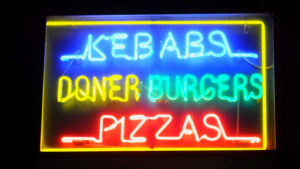We commonly see queues of drunken party-goers outside chip shops late at night, but what is it about this social context that makes those chips taste so good? As someone who doesn’t normally eat chips or go to a takeaway shop, I am interested to know why they are so much more satisfactory when eaten in a drunken state on a cold Edinburgh street surrounded by friends.

Figure 1. A fast food shop sign glows with invitation to drunken students. What would normally be deeply unappealing promises something vastly more appetising following a night out. (Flickr 2022)
The influence of alcohol certainly has an impact on our food choices, as we are more likely to crave unhealthy foods and eat more ‘junk food’ than when sober (Kruger and Kruger 2015). However, I am more interested in how our social context influences our tasting experience of chips following a night out.
Taste is not a purely individual matter, it depends on our socio-cultural context (Hojlund 2015). “Tasting means different things in different contexts” (Hojlund 2015, p2), as our enjoyment of food is influenced by our mood, as well as the company and setting we are in. The taste of greasy chips at 2am on a cold Edinburgh street with friends after a fun night is very different to if we were served those chips in a restaurant, or cooked them at home.
Much like how fish and chips at the beach has become a British tradition, we now have cultural associations with eating chips or other takeaway food when drunk. It has become somewhat a tradition to get greasy food late at night after drinking, and this expectation makes us more likely to choose to buy chips and enjoy eating them. Korsmeyer and Sutton (2011) state that our expectation and anticipation of the salty flavour of chips heightens our taste of them, meaning that the more we look forward to getting chips on the way home during a night out, the more we will enjoy them. This is something I have experienced, as if someone mentions getting food on the way home from a club, there is never a time where other group members turn down the idea, instead all experiencing a growing desire and anticipation for the taste of them.
The main contributor to me enjoying chips after a night out is the influence of others around me doing the same thing. Whilst there is no direct peer pressure to buy chips, we are perhaps influenced by the fear of missing out if our friends are enjoying a late night snack and we choose not to. Additionally, Hock and Bagchi (2018) suggest that the larger the crowd in the shop, the more chips we are likely to buy and consume, so the late-night crowding in popular fast-food shops has an influence on our likelihood of eating chips. The social gathering in a chip shop or on the street late at night contributes to how we perceive the taste of the chips, so they are likely to taste better if we are surrounded by people we like.
Word count: 500
Bibliography
Flickr (2022). Kebabs. [image] Available at: <https://live.staticflickr.com/65535/51853121774_c6d1dbc0ca_h.jpg> [Accessed 23 March 2022]
Hock, S.J. and Bagchi, R. (2018) ‘The Impact of Crowding on Calorie Consumption’, Journal of Consumer Research, 44(5), pp. 1123-1140
Højlund, S. (2015) ‘Taste as a social sense: rethinking taste as a cultural activity’, Flavour, 4(6)
Korsmeyer, C. and Sutton, D. (2011) ‘The sensory experience of food’, Food, Culture and Society, 14(4), pp. 461-475
Kruger, J.S. and Kruger, D.J. (2015) ‘The impact of alcohol consumption on food choices among college students’, American Journal of Health Studies, 30(2), pp. 70-75



Leave a Reply